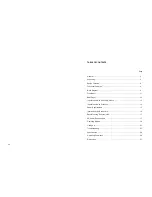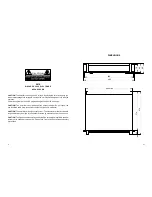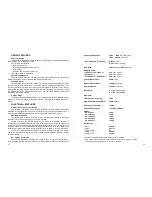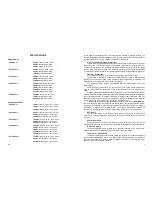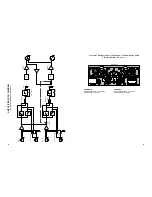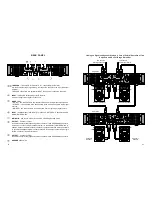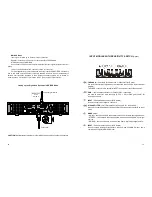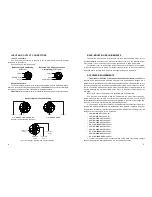
6
27
Built-in Two-Way Crossover
(only for input modules with a crossover)
This feature allows to pick up the respective frequency range both for this amplifier and
for any other equipment connected to it (such as another amplifier or an active speaker
system). The amplified frequency range can be set individually for each channel. The
crossover allows to switch between two preset crossover frequency settings. The desired
frequency setting is selected with a slide switch. The crossover allows individual setting of
both the signal frequency range (high, low, full-range signal) being sent to the line output,
and the signal frequency range to be amplified by the amplifier itself. Such switching features
allow to create two-way sound reinforcement systems driven by two amplifiers, a V-series
amplifier being one of them.
In addition, it is possible to change the input stage crossover frequency by replacing
standard crossover filters with custom ones. For more information about installation and
purchasing the crossover filters, please, consult our local dealer or the manufacturer
’
s
support service by e-mail: support@parkaudio2.com
Line Outputs
ch)
The amplifier line outputs are parallel to the inputs (each along the respective channel)
and provide for parallel connection of several amplifiers with standard signal cables using
XLR connectors.
Switch-Selectable Active Line Output
(only for input modules with a crossover)
This feature allows to send the line signal to another amplifier. If this is the case, the
output can be set to deliver either the whole (full-range) signal (for two parallel amplifiers fed
from a common signal source) or its required frequency component (high or low) processed
up by the built-in crossover (when two-way systems are in operation). The connection to the
line output is done with XLR connectors. The output frequency range can be set with a slide
switch located on the rear panel. The amplifier
’
s line outputs are parallel to the inputs (each
along the respective channel). They make it possible to link up with several parallel amplifiers
interconnected with XLR-wired signal cables.
Sensitivity Switch
(only for input modules with a sensitivity switch)
This switch allows to select the required sensitivity of the amplifier, viz. 0.775 V, 1.4V
or to set the fixed gain rate of 32 dB.
Sensitivity is selected with a slide switch (individual for each channel) located on the
amplifier
’
s input module.
Input Filter
(only for input modules with a sensitivity switch or with a crossover)
To improve the performance of speaker systems, the amplifier incorporates a switch-
selectable high-pass 4-th order filter with a 24 dB per octave slope rate. This is the filter
recommended by all major speaker systems manufacturers.
This filter cuts off any signals below 35 Hz, which generally cannot be reproduced by
most of the professional speaker systems.
The filter significantly reduces the travel of the LF loudspeaker cone below the
loudspeaker frequency cut-off point. Especially, this is the case when phase inversion
systems are used. Therefore, the filter makes it possible to increase the power applied to
TROUBLESHOOTING
No Sound Signal on the Amplifier`s Output
POWER LED is OFF:
–
power cable is damaged;
–
no power.
But for POWER LED all other LEDs are OFF:
–
no input signal;
–
input level attenuators are set to minimum position.
CLIP LED goes ON while output level LEDs are OFF:
–
output cable is short-circuited;
–
load impedance is too low.
ALARM LED goes ON:
–
the unit is in the DC-protection mode;
–
the unit is in the HF protection mode.
The problem may be with the signal source. Try disconnecting the signal source from
the amplifier.
Sound Distortion
SIGNAL LED is ON while CLIP LED is OFF:
–
applied input signal is distorted before it gets to the amplifier;
–
speakers are damaged.
If input attenuators are set close to their minimum position, distortion may occur as a
result of input stage overload with high input signal.
Both SIGNAL and CLIP LEDs are ON:
–
overload caused by low impedance or high input signal.
Low frequency is missing in the response
(only when an input module with a crossover is installed)
Wrong crossover settings (CROSSOVER switch is set to HI).
Speaker systems may be damaged, or low frequency is missing in the input signal.
High frequency is missing in the response
(only when an input module with a crossover is installed)
Wrong crossover settings (CROSSOVER switch is set to LO).
Speaker systems may be damaged, or high frequency is missing in the input signal.
Hum and Interference
Be sure to have the power cable 3-wire plug properly connected to the grounded outlet.
Disconnecting the ground contact usually does not eliminate hum and interference, but may
pose a risk of electric shock.
To reduce hum and noises, use balanced connections.
It is recommended to have the GROUND LIFT switch set to GROUNDED to preclude
potential electric shock hazard. However, sometimes hum may be caused by current flow
through ground loops. In this case, setting GROUND LIFT to UNGROUNDED may resolve the
problem.



